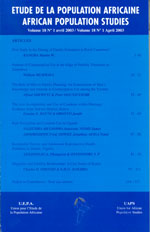
|
African Population Studies
Union for African Population Studies
ISSN: 0850-5780
Vol. 20, No. 2, 2005, pp. 1-24
|
 Bioline Code: ep05009
Bioline Code: ep05009
Full paper language: English
Document type: Research Article
Document available free of charge
|
|
|
African Population Studies, Vol. 20, No. 2, 2005, pp. 1-24
| en |
Fertility Trend in Ghana
Gaisie, Samuel
Abstract
The study traces the likely route of the movement of fertility through the demographic transition. The information is critical for construction of population projections as well as for monitoring and evaluating action programmes The original P/F ratio method and modified versions, one through the intermediary of relational Gompertz model , for analysing birth history data, are employed in assessing data quality as well as in determining fertility levels and trends. The derived estimates suggest that the level of fertility in Ghana fell from about seven children per woman in the 1960s and 1970s to 4.6 children per woman by the turn of the 20th century. The pace of the decline, slowed down considerably between the late1990s and the beginning of this century when the total fertility rate dropped from 4.8 to 4.6 The changing youth population, substantial increase in the number of females aged 15-49 years, increasing aging population and the huge discrepancy between contraceptive use and the level of fertility are some of the crucial issues that call for policy options and research-based evidence for designing context specific development strategies and action programmes
|
| |
© Copyright 2005 - Union for African Population Studies
Alternative site location: http://www.uaps-uepa.org
|
|
